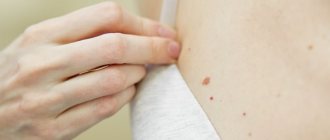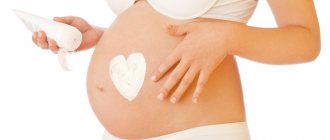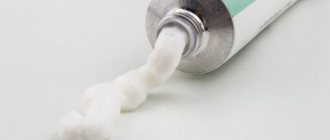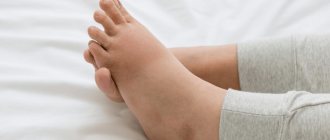Expecting a baby is one of the most wonderful periods in a woman’s life. Her thoughts are focused on dreams of the future baby and joyful worries about children's things, a stroller, and toys. But changes in the body sometimes prepare unpleasant surprises for the expectant mother. Thus, many women feel dryness, itching and burning in the intimate area during pregnancy. What caused them?
Skin care
Everyone knows that the skin of a pregnant woman’s face sometimes seems to glow from within. This is due to the fact that due to hormonal changes, more blood flows to the face and it looks refreshed. However, pregnant women also experience skin problems.
Age spots are a very common occurrence during this period. They can appear on the face, stomach and chest. As a rule, they go away within 4–5 months after the birth of the child.
However, to reduce their expression on the face, dermatologists strongly recommend using sunscreen with SPF of at least 30, and also not neglecting foundation - this will make you feel attractive and confident. By the way, BB and CC creams successfully combine the functions of moisturizing, sun protection and skin toning.
Acne - peeling and rashes on the skin of pregnant women - is associated with changes in the hormonal balance in the body. Skin may become drier, more sensitive and more prone to irritation. Don't worry, this is temporary.
- Use sun protection.
- Choose a new moisturizer for sensitive skin.
- Cleanse your skin with soft facial foams.
- Use anti-acne products, but first make sure that they do not contain substances that are not recommended for pregnant women.
Why does atopic dermatitis develop during pregnancy?
The diagnosis of “atopic dermatitis” is typical not only for pregnant women. Anyone can experience it, but more often the disease manifests itself in childhood. The reason is heredity - if at least one of the parents is atopic, then the risk of encountering dermatitis in the child increases. The first signs of the disease may appear in adulthood.
Atopic dermatitis often occurs for the first time in pregnant women. Before this, the woman may not have encountered such a disease. The reason is associated with increased production of cortisol, a hormone that plays an important role in fetal development and is also responsible for the formation of allergic reactions.
The exacerbation is also due to a decrease in immunity, which is necessary to ensure that the mother’s body does not reject the fetus. This explains the development of atopic dermatitis during pregnancy. The risk is especially high if a woman had such a diagnosis or a tendency to allergies before conception. Provoking factors also include:
- excessive psycho-emotional stress;
- consumption of allergenic foods;
- unfavorable environmental conditions;
- chronic diseases of the digestive system;
- endocrine disorders;
- hormonal changes in the body of pregnant women.
What cosmetics are harmful for pregnant women?
Decorative cosmetics, as a rule, do not contain ingredients harmful to pregnant women. On the contrary, experimenting with makeup is a wonderful opportunity for pregnant women to take care of themselves and be positive.
With “care” products everything is different. Dermatologists recommend that during pregnancy you be attentive to what ingredients are in the creams, tonics and other cosmetics that a woman applies to her skin. The fact is that many substances can penetrate the skin and enter the bloodstream, which can potentially harm the child.
Here is a list of ingredients that are considered unsafe for pregnant women.
- Retinoids. They are usually added to anti-aging cosmetics. These are vitamins of group A, which accelerate the renewal of skin cells and prevent the breakdown of collagen, but they can harm the unborn baby if taken orally. Although there is no official data on the dangers of retinoids when used externally, doctors still recommend refraining from using cosmetics with this ingredient while expecting a child.
- Salicylic acid and BHA, one of its forms. It is used in a large number of cosmetics and is intended to treat acne. It also harms the unborn baby, primarily when taken orally. Doctors do not object to the external use of salicylic acid in creams or tonics - if its concentration does not exceed 2%. But if this additive is in scrubs and peels, salicylic acid penetrates deeper into the skin, and this is already considered unsafe for the baby.
- Soy. Products made from it are useful for pregnant women when added to the diet. How is soy harmful when used externally? Cosmetics based on this ingredient make age spots darker thanks to the phytoestrogens contained in soy. By the way, bergamot oil has the same effect.
What is included in oils and creams for stretch marks for pregnant women?
- Oat extract
. Promotes skin regeneration, softens and moisturizes it. - Sophora japonica extract
. Strengthens capillaries and also brightens the epidermis. - Arnica extract
. Improves vascular tone, restores skin after damage. - Wheat germ oil
. Stimulates the synthesis of collagen and elastin. - Shea Butter
. Contains natural latex, which improves the elasticity of the skin. - Almond oil
. Returns tone and elasticity to the epidermis. - Grape seed oil
. Exfoliates dead cells, stimulates blood circulation and lymph flow. - Jojoba oil
. It contains amino acids similar in structure to collagen - they provide the skin with elasticity and firmness.
How to deal with stretch marks
Is it possible to prevent stretch marks during pregnancy? Dermatologists say that genetic predisposition plays a key role here, and about half of women observe the appearance of stretch marks while expecting a child - on the stomach, chest, buttocks and thighs. Even special creams against the appearance of stretch marks will not protect against them. If women in your family have them on the skin, then you are not immune from their appearance. Here are the factors that can increase the likelihood of stretch marks:
- multiple pregnancy;
- rapid weight gain;
- you are carrying a large baby;
- you have excess amniotic fluid.
Dermatologists still recommend preventive measures:
- taking a contrast shower with simultaneous massage with a hard washcloth, you can use scrubs;
- daily moisturizing of the skin with vegetable oil, milk or body cream.
You can also smear the oil on the expectant mother’s tummy, but no one can guarantee that there will be no stretch marks. Don’t get hung up on this: if they appear, their manifestations can be reduced.
A tan
During pregnancy, it is better not to use a solarium or use self-tanning products. If you really need to change your complexion, it is better to choose BB cream or mineral powder.
Sunbathing on the beach in direct sunlight is also not beneficial - it is better for the expectant mother to relax in the shade, remembering to use sunscreen. There is definitely no place for saving in this matter - we choose a cream with the maximum protection factor (you can use “children’s”) and use it as often as the specific instructions suggest.
Nails and hair during pregnancy
Great news: while expecting a baby, the expectant mother's nails become stronger, and her hair becomes shiny and thicker. Surprises are also possible: wavy hair can become straight, or vice versa.
- •\tIt is worth keeping in mind that the hair seems thick not because more hair has begun to grow, but because it is now falling out less. In normal life, on average, we lose about 100 hairs per day, and during pregnancy, the process of hair loss slows down significantly. After childbirth, the hair will return to its normal state.
- Many women are concerned about excess hair growth on the face and body - do not worry, this is temporary. Choose a hair removal method that is convenient for you. However, remember that depilatory creams are not considered completely safe for pregnant women.
- Also, you should not start using a home epilator if you have not had such experience before: as a rule, the number of ingrown hairs increases during pregnancy, and it is extremely difficult to deal with them, so it is better not to increase the likelihood of their occurrence.
Is it possible to dye your hair during pregnancy?
There is no scientific evidence confirming the dangers of using conventional paint with ammonia during pregnancy. However, it is recommended to temporarily switch to more gentle, possibly unstable, paints or coloring instead of classic coloring.
- During this period, you need to especially strictly follow the instructions for hair dyes - check them for allergenicity by applying a little dye to the skin and waiting the right time. Do not under any circumstances try to dye your eyebrows or eyelashes with hair dye: this is very dangerous and can lead to irreparable consequences, including blindness.
It is worth remembering that during this period it is not recommended to experiment with perm: firstly, the substances included in the special mixture may be unsafe for the child, and secondly, the hair does not behave as usual. The result may be unpredictable.
Why do stretch marks occur?
There may be several reasons for the occurrence of stretch marks, or stretch marks, but the main one is insufficient cell regeneration. When the volume of the abdomen increases, there are not enough cells. They do not have time to share in the required quantity, which is why the surface of the epidermis becomes thinner.
The thin layer of epidermis in itself is not a stretch mark. But the area of the body with this problem is impacted: a sudden movement, a pulled muscle, an awkward turn - the weak epidermis is torn and micro-tears appear.
The body strives to “patch” them as quickly as possible. New tissue is born, but, alas, not like healthy skin, but scar tissue. Below it, processes associated with injury occur: torn capillaries give the striae red, like a cut, then lilac and violet colors. Over time, the internal damage heals and only a white stretch remains, similar to a scar. It cannot be hidden under any tan: unlike healthy cells, scar cells do not react to ultraviolet radiation.
Other causes of stretch marks may include::
- Poor nutrition : During pregnancy, the body especially needs vitamins. Without fresh vegetables and fruits, protein, complexes of groups B, C and D, cells do not receive what they need, so they become less elastic. This increases the risk of microtears in the tissue, even if the cells themselves are still sufficient to maintain the required thickness of the epidermis.
- Excess or lack of physical activity . With fanatical exercise, as well as with the wrong selection of exercises, the muscles are under constant stress. The epidermis becomes thinner and tears. For healthy fitness, taking a day or two off after a workout is recommended. This way the muscles remain toned, but at the same time have time to relax. With a sedentary lifestyle, muscles, on the contrary, atrophy. The skin becomes loose and loses elasticity because sluggish blood flow does not deliver enough oxygen.
- Hormonal disbalance . The body prepares for childbirth and produces progesterone, a hormone that relaxes the uterus and along with it the rest of the muscles and connective tissues. Due to loss of tone, the epidermis is easily torn.
- Smoking and alcohol . There are obvious reasons why the skin of an ordinary person deteriorates. Alcohol and nicotine interfere with the production of elastin and collagen - substances responsible for skin elasticity.
- Early or late age of a woman . By the age of 18, the body is not ready for the hardships of pregnancy, and after 30 years, not enough collagen is produced.
- Repeated births . It takes 2 years for the body to recover. Before this period, hormonal levels will not have time to improve, and time is also needed to replenish vitamin reserves and put your figure in order.
- Feeding _ The lactation period is a very heavy burden for the breasts. To avoid stretch marks, you will need bandages and special underwear, as well as stretch mark cream. However, before using a cosmetic product, make sure that it can be used during lactation.
- Having obesity or diabetes . The body is already functioning beyond normal limits, and in the case of diabetes there are even disturbances in the endocrine system.
- Heredity is more of a risk factor than a cause. But it also needs to be taken into account. If your mother and grandmother had stretch marks, most likely you will have them too.
Knowing the reasons for their appearance, you can avoid stretch marks simply by taking precautions in time. If stretch marks do occur, it is possible to get rid of them. The main thing is to choose the right method of treatment and not to cause stretch marks - young colored stretch marks are easier to cure than old white ones.
Breast care during pregnancy
As a rule, everyone is ready for the fact that during pregnancy the breasts become larger - on average by 1 - 2 sizes. Her weight increases, and the ligaments cannot cope with the increased load. After breastfeeding is completed, it may become larger or smaller, everything is individual.
But if its size cannot be influenced, then is it possible to prevent the change in shape? Also, many women note that during pregnancy and childbirth, the nipples become larger and darker. Breast sensitivity may change during this period. What to expect?
1. As for the nipples, their size may decrease after breastfeeding ends, they may become lighter, but in each case everything is individual. The sensitivity of the nipples, as a rule, returns to the state it was before pregnancy.
2. Experts say that it is impossible to prevent changes in breast shape. This is a natural phenomenon. Here are some remedies you can resort to to make your breasts firmer:
2.1.1. after consulting with a specialist, do planks and other special exercises - they affect the pectoral muscles, and not the breast tissue, but nevertheless they can have an effect;
2.1.2. breast massage combined with almond, coconut or olive oil will improve skin tone. You need to be careful not to massage the nipple area, so as not to stimulate the production of oxytocin, which can cause uterine tone. It is recommended to do it about three times a week;
2.1.3. good posture, which can be achieved through yoga and gymnastics - as a result, the shape of the breasts improves;
2.1.4. It is recommended to wear special underwear, first of all, for comfort - during pregnancy, the breasts increase in size and need additional support.
Tips for intimate hygiene for an expectant mother
Burning and itching in the intimate area during pregnancy can be prevented. Here are 6 simple tips to help reduce your risk of developing infections:
- Take a shower no more than 2 times a day. Water and soap remove natural protection - beneficial microbes.
- Choose intimate hygiene gels containing lactic acid or plant extracts: linden, chamomile, blue lotus, white tea. These natural components have a positive effect on the condition of the most delicate area of our body.
- Dry your body thoroughly after intimate toilet with a cotton towel. Do not share a towel with other family members.
- Wear panties made of 100% cotton, which help your skin breathe and do not create a greenhouse effect, especially in hot weather.
- Use pads filled with cotton extract. They allow oxygen to pass through well, which destroys yeast.
- Replace the bath with a shower. Hot, soapy water can bring dirt into the body and wash away beneficial bacteria. If you really want to soak in the bath, wash yourself in the shower first. Use sea salt instead of foam.
How to choose a bra during pregnancy
Doctors believe that there is no urgent need to use specialized underwear for pregnant women. The main thing is that it does not squeeze the chest.
- Breasts grow in the 1st and 2nd trimesters, only reaching the size that will remain during the feeding period by the 3rd.
- You can choose the same bras for pregnant and nursing women and immediately buy bras that need to be partially unfastened for breastfeeding.
- When choosing a bra, it is important to pay attention to the fabric composition: cotton and lycra are preferable. Such underwear stretches when necessary without causing discomfort. The straps should be wide and the cups should cover the entire chest. There is no need to choose bras with underwires: they can move and pinch the duct during breastfeeding.
- From the second trimester, colostrum may be released from the nipples - use special bra inserts.
- How many bras should you buy? As a rule, women during pregnancy and lactation need three special bras.
Baby
The 19th week is characterized for the fetus by intensive growth of the limbs in length, an increase in size, and a slowdown in head growth. Its length is already 25 cm, and its weight is approximately 250-300 g. The child changes greatly in appearance, his body no longer looks disproportionate.
The fat under the skin allows the relief of the body to change slightly and become rounded. This brown fat is formed at 19-20 weeks. After birth, it is he who will perform the function of thermoregulation and protect the child from hypothermia or overheating. With age, this fat disappears and remains only in certain places: in the thickness of a person’s cheeks, kidney area, under the armpits, and shoulder blades.
At this stage, the formation of permanent teeth, which are located in the dental plate under the rudiments of milk teeth, and the maturation of the brain also occur. Special processes allow connections between neurons to be established. Cells intertwine with each other and create a whole system for transmitting impulses, ensuring the synchrony of the brain. The structures responsible for touch, taste, vision, hearing, and smell are actively developing.
Changes also occur in the hematopoietic system. The spleen is connected to the process of formation of blood cells, produces leukocytes, the task of which is to protect the child’s body from external and internal factors. Until 19-20 weeks, the fetal blood consisted only of red blood cells, and at this stage its composition changes sharply and approaches the composition of the blood of a newborn.









